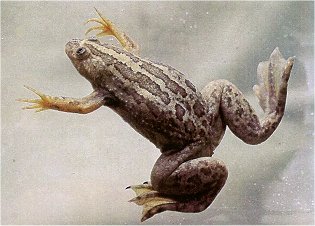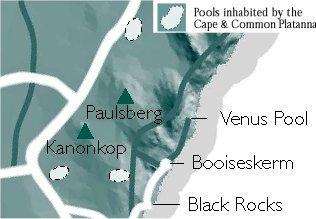|

Commonly known as the Cape Platanna, Xenopus
gilli
has a small head, larger
body measuring some 5cm
from snout to vent, dark stripes on the back
and mottled
patterns on the stomach.
|
|

This rare species is quite unique, as it prefers the seasonal and high
acidic levels of the black water lake-lets of the Cape Floral Kingdom. This differs from its cousin, the Common Platanna (Xenopus
laevis), where it prefers permanent standing water bodies and lower acidic levels. X. gilli is therefore only found in the
south western region of South Africa, and here it is becoming one of the most endangered amphibians in the world. Its story
gives a view on the history of land management and conservation practices in the area that is now the Cape Peninsula National
Park.
Xenopus gilli has faced many threats. At the Cape of Good Hope, as in other areas in the south western Cape, unwise land
development and management practices contributed to the threatened status of this species.
In the early years various farming practices and the construction of dams
destroyed the gillis natural habitats. In what was then the Cape of Good Hope Nature Reserve, managements decision to create
a game farm led to the introduction of fauna alien to the area. To cater for these animals some of the natural wetlands were
excavated to create water holes. Alien plants such as Rooikranse was introduced to stabilise sand dunes.
As the gilli and laevis came to inhabit the same water bodies, they started to interbreed, resulting in hybrid populations.
This hybridisation began to drive the gilli further toward extinction, because the hybrid males are sterile. Not only were
there ever fewer suitable habitats for the gilli, but its attempts to breed were now also less successful.
On realising the impacts on the Xenopus gilli, scientists and managers
came up with various suggestions to save the rare species. These included blasting with dynamite, biochemical poisons, the
introduction of alien predatory fish and electric shock treatments, to permanently remove the laevis. For research purposes,
the method of tattooing the belly of the frogs was proposed.
Thankfully these suggestions were not implemented. Over time
scientists became more knowledgeable and concerned about not just single species, but the ecosystem as a whole.
Resources and stronger legislation became available with a change in the
conservation status of the area, when the Cape Peninsula National Park was proclaimed in 1998. This proclamation recognised
the areas importance as a national asset.
Steps have been taken to rehabilitate the disturbed habitats through alien clearing
programmes for the eradication of all alien vegetation on the Peninsula, and the removal of alien fauna is also under way.
These actions are to benefit not only single threatened species such as Xenopus gilli, but entire ecosystems.
Very Much Thanks to:

| Where do X. gilli live? |

|
|



